Effect of moisture content and frequency variation on dielectric properties of bamboo (Phyllostachys heterocycla cv. pubescens)
Moisture content of bamboo and frequency are the most important factors that affects dielectric properties of bamboo material. Dielectric properties of bamboo is one of the most important factors to determine the highfrequency hot pressing process parameters of glued laminated bamboo. Therefore, study on dielectric properties of bamboo has important significance. Bamboo was adjusted moisture content under laboratory conditions for 0-18%. Effect of moisture content and frequency variation on dielectric properties of bamboo was determined by using the 4294A Precision Impedance Analyzer with the 16451B. Dielectric properties including dielectric constant (e’) and dielectric loss tangent (tan d) have been done in the moisture content range from 0% to 18% and in the frequency range from 60 Hz to 6 MHz. The results showed that the dielectric constant (e’) and tan d increase with the increasing moisture content and decrease with the increasing frequency. Dielectric constant and tan d increased slowly with the moisture content below fiber saturation point (FSP), increased sharply with the moisture content around the FSP. Dielectric constant and tan d decreased obviously with the frequency below 6 kHz, but changed slowly when it above 6 kHz
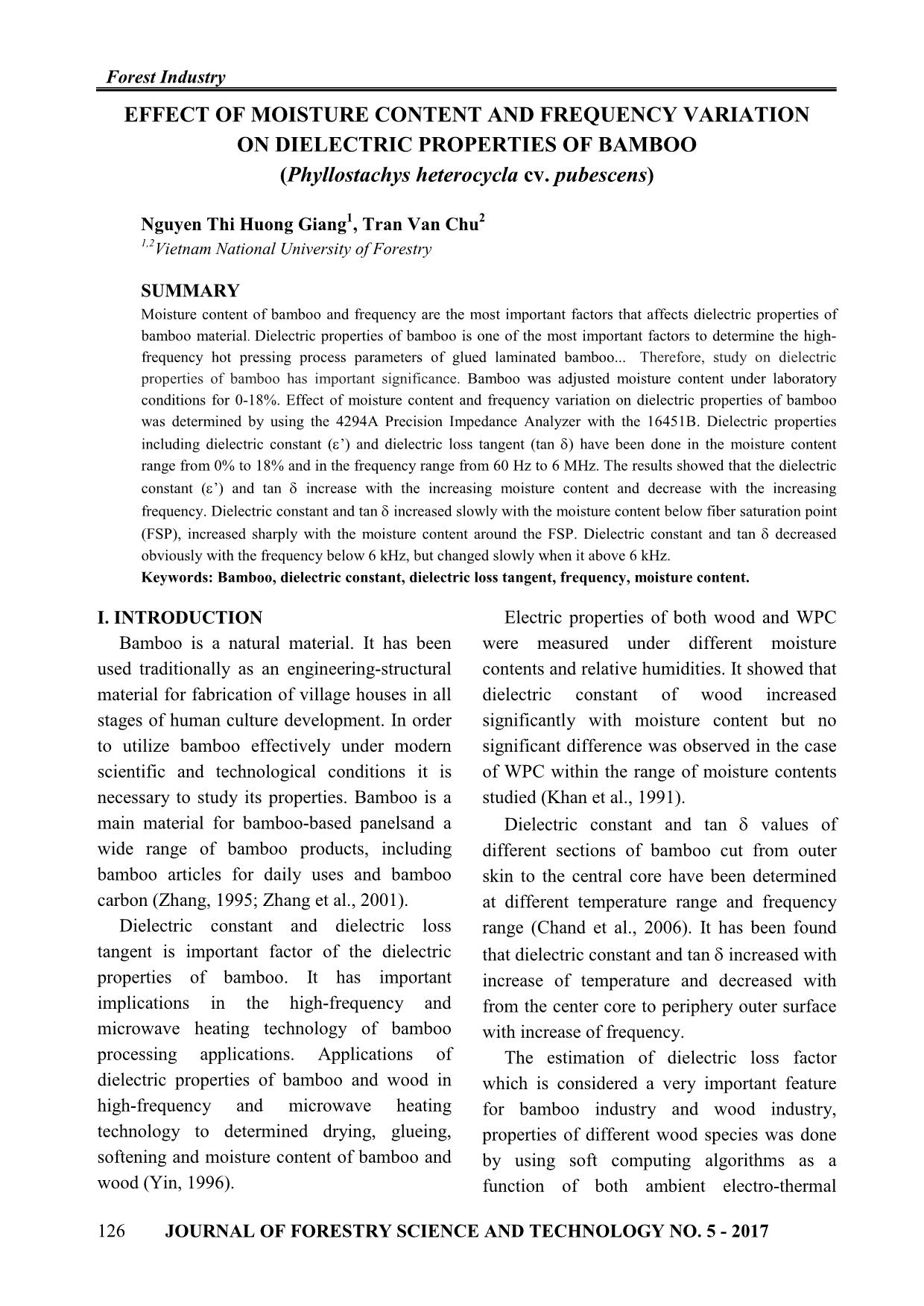
Trang 1
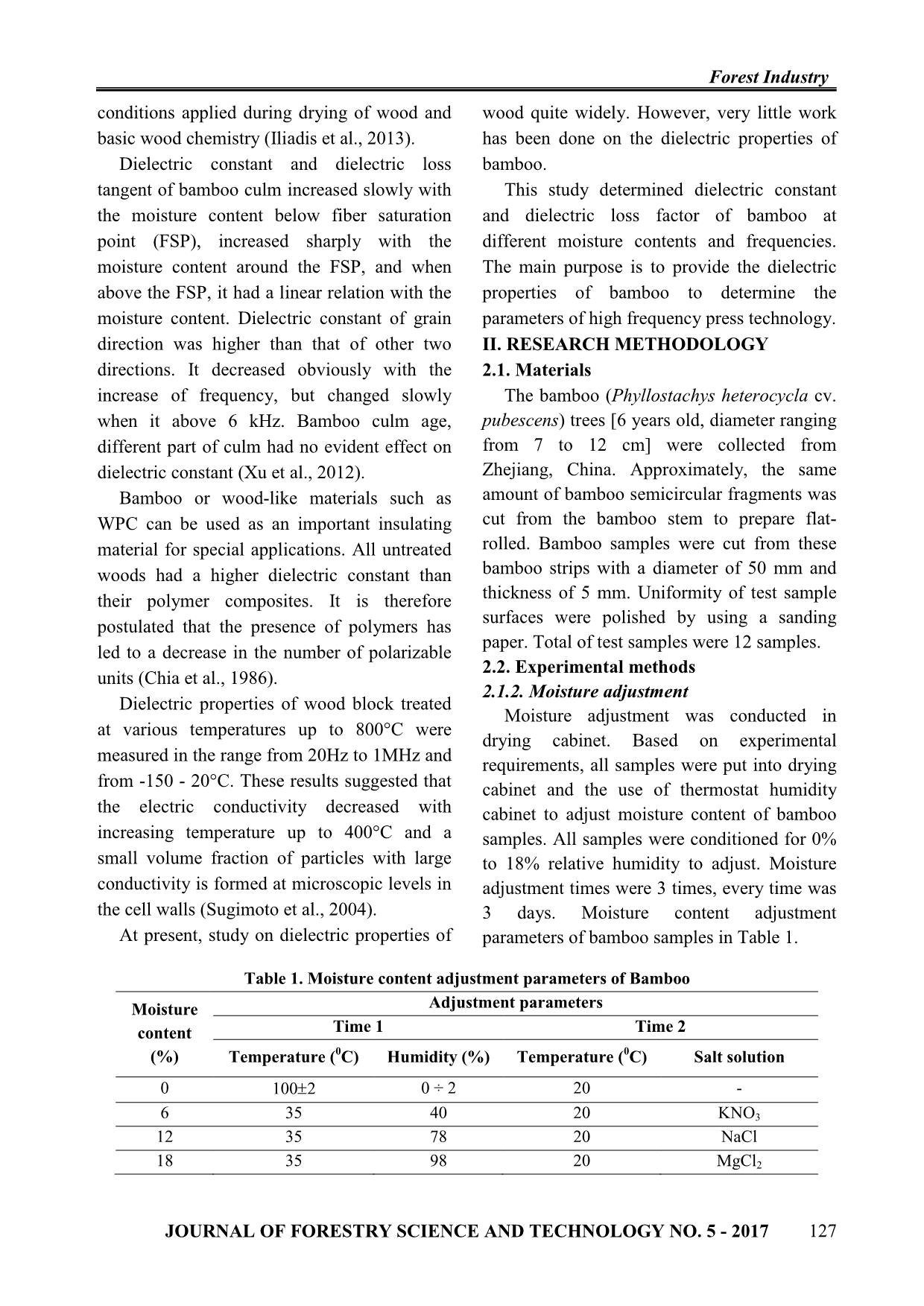
Trang 2

Trang 3
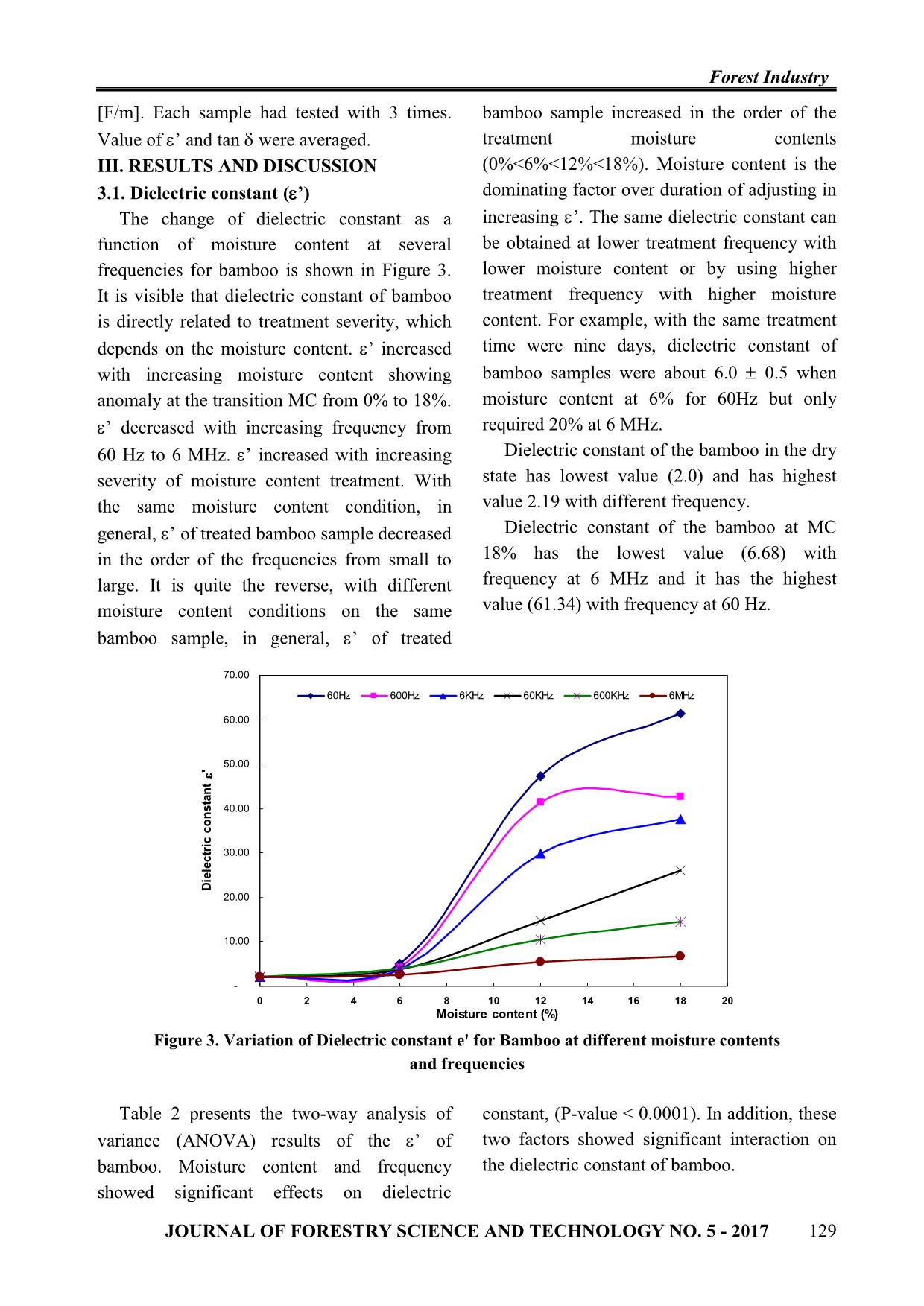
Trang 4
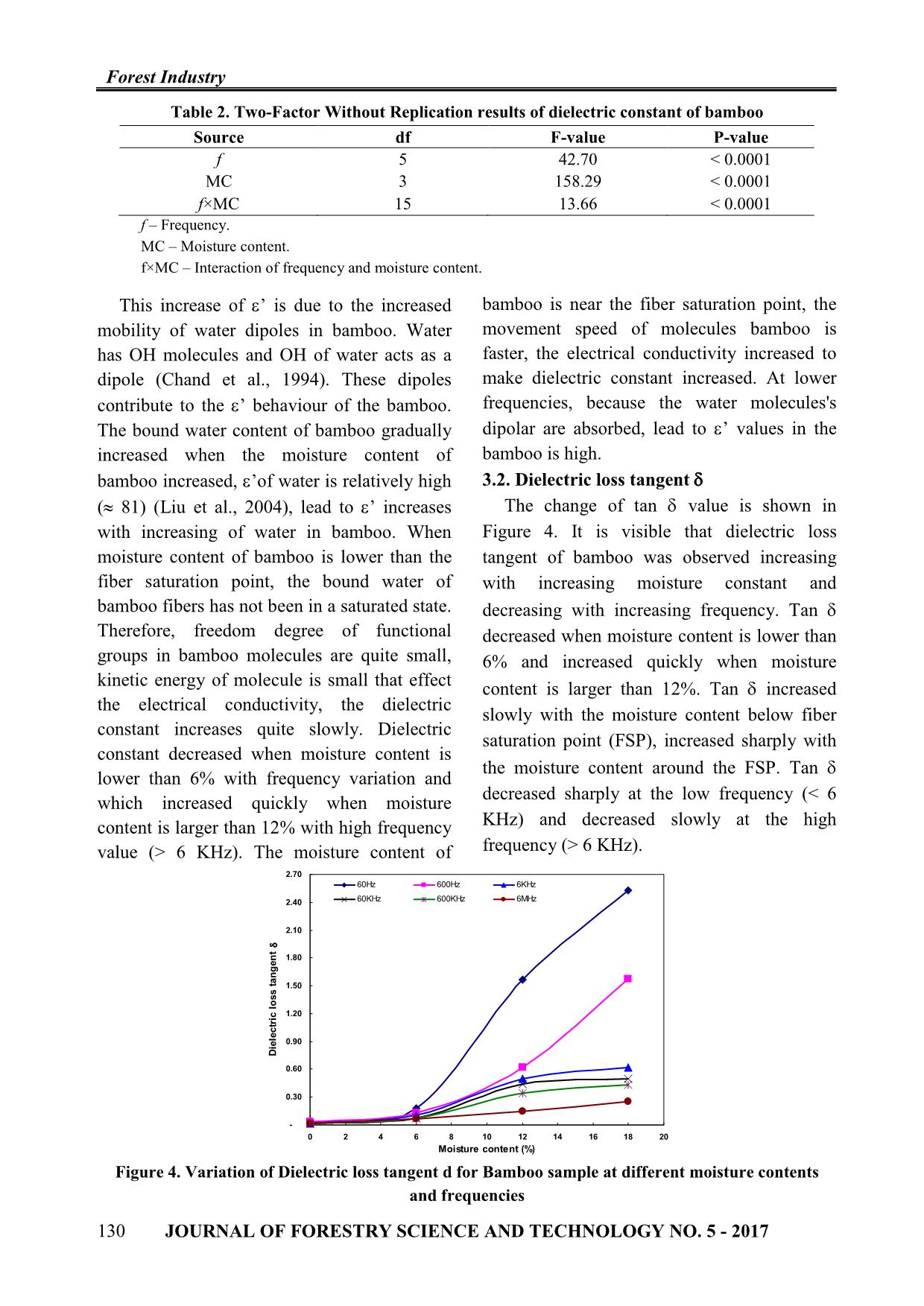
Trang 5
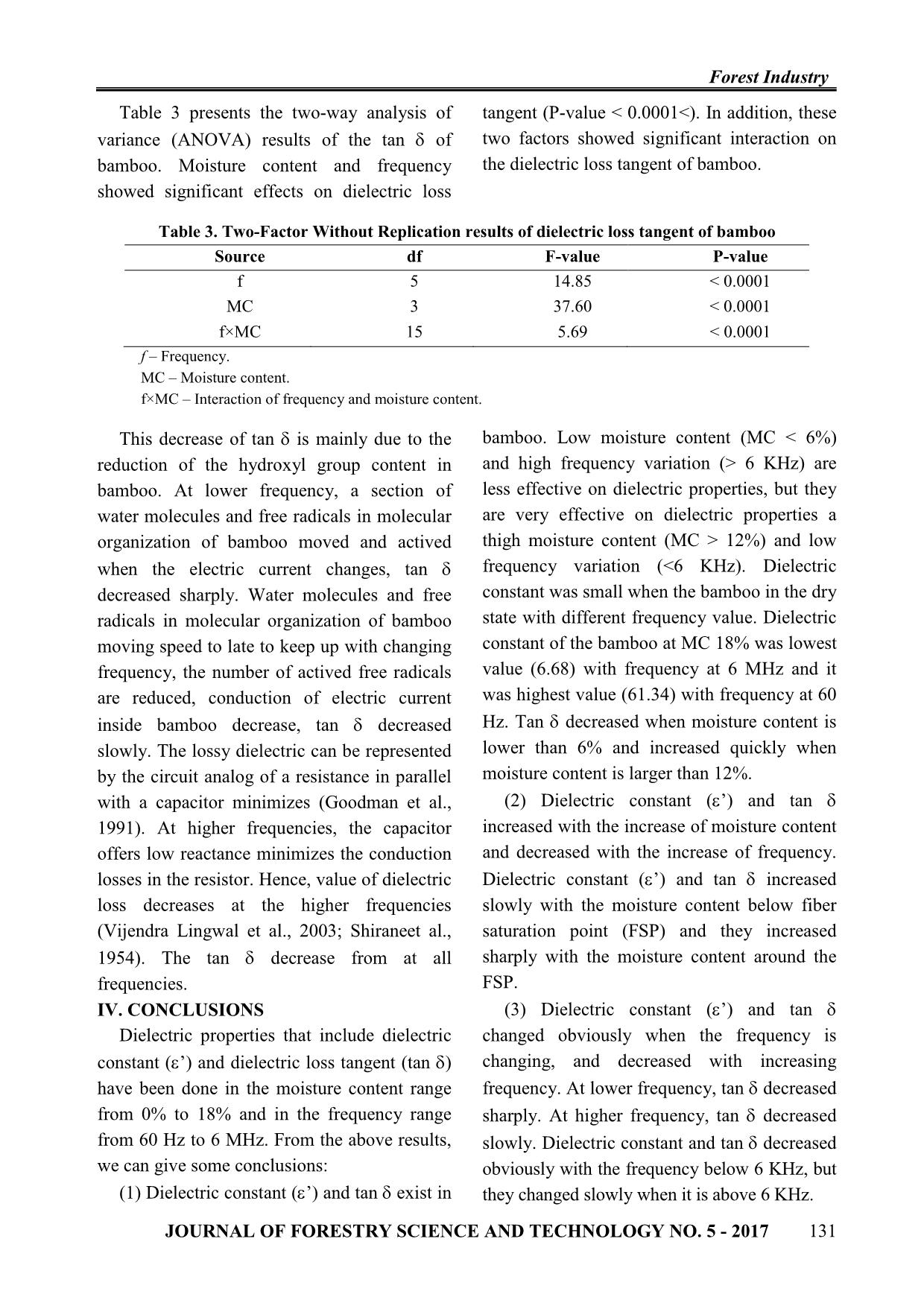
Trang 6
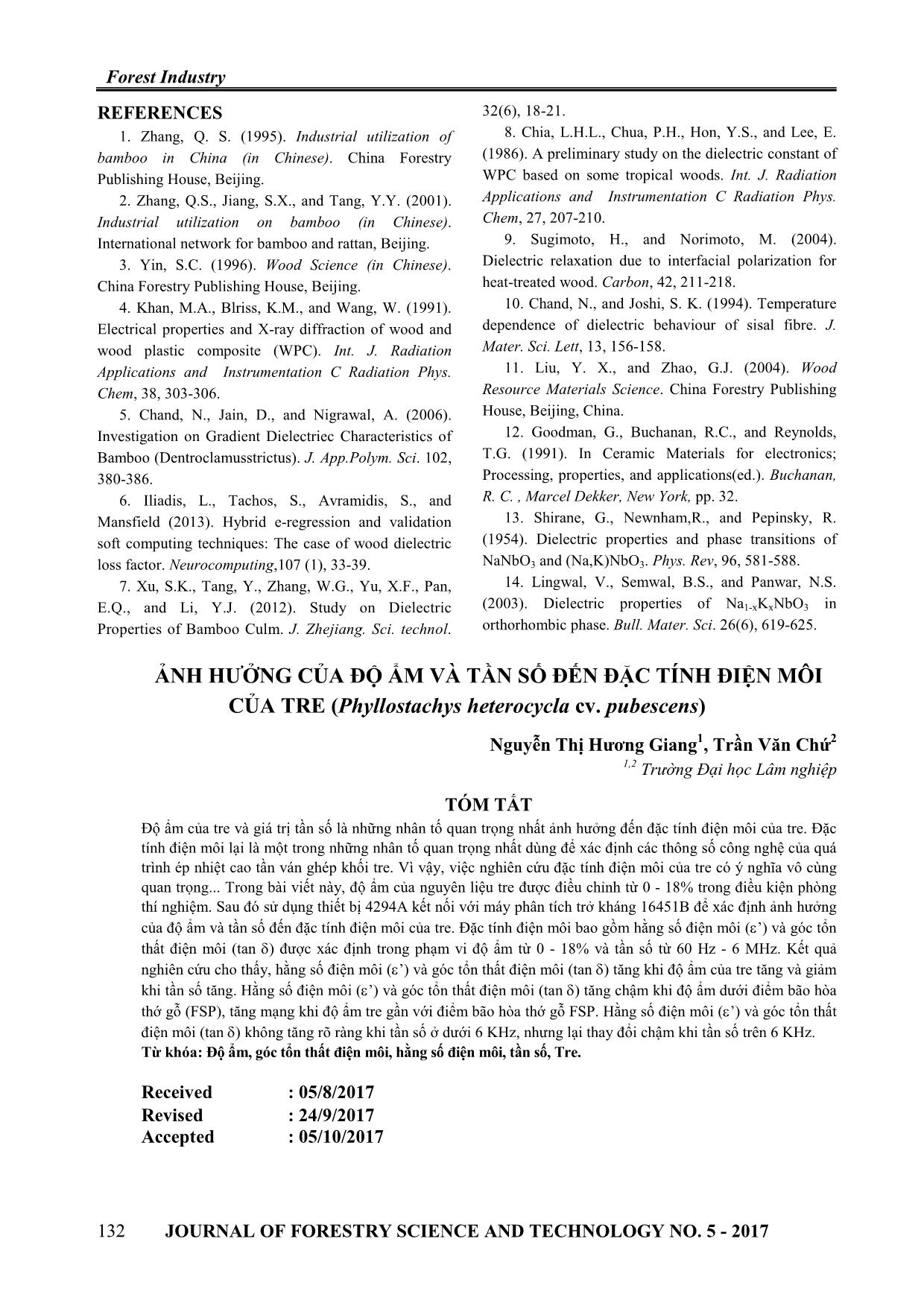
Trang 7
Tóm tắt nội dung tài liệu: Effect of moisture content and frequency variation on dielectric properties of bamboo (Phyllostachys heterocycla cv. pubescens)
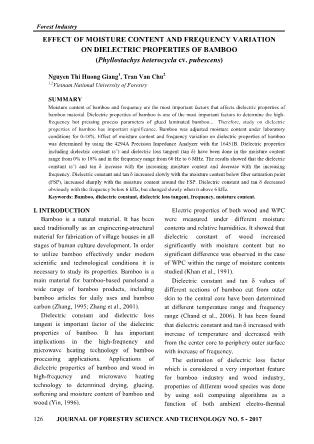
s, every time was the cell walls (Sugimoto et al., 2004). 3 days. Moisture content adjustment At present, study on dielectric properties of parameters of bamboo samples in Table 1. Table 1. Moisture content adjustment parameters of Bamboo Moisture Adjustment parameters content Time 1 Time 2 (%) Temperature (0C) Humidity (%) Temperature (0C) Salt solution 0 100 2 0 ÷ 2 20 - 6 35 40 20 KNO3 12 35 78 20 NaCl 18 35 98 20 MgCl2 JOURNAL OF FORESTRY SCIENCE AND TECHNOLOGY NO. 5 - 2017 127 Forest Industry The moisture content (MC) of the samples immediately after drying. were calculated according to the following 2.1.2. Experimentalmethod formula: MC (%) = [(m1-m0)/m0]×100, where Figure 1 displays the flow chart when using m1 is the weight of the sample before drying, the 16451B for permittivity measurements. and m0 is the weight of the sample Prepare the Attach the guarded Connect the 16451B Cable length dielectric material electrode compensation Compensate the Set the measurement Adjust the electrodes Compensation residual impedance conditions for adjustment Insert the material Cp-D measurement Calculate permittivity Figure 1. Measurement procedure flow chart for the 16451B When using an impedance-measuring capacitor. The measured capacitance is then instrument to measure permittivity, the parallel used to calculate permittivity. In an actual test plate method is usually employed. An setup, two electrodes are configured with a test overview of the parallel plate method is shown fixture sandwiching dielectric material. The in Figure 2. impedance- measuring instrument would The parallel plate method, also called the measure vector components of capacitance (C) three terminal method in ASTM D150, and dissipation (D) and a software program involves sandwiching a thin sheet of material would calculate permittivity and loss tangent. or liquid between two electrodes to form a Figure 2. Parallel plate method 2.1.3. Measurement of Dielectric frequency range from 60 Hz to 6 MHz. The measurements of dielectric constant e’ was calculated by using the following (e’) and tan (d) values of bamboo samples equations: e’ = (ta×Cp)/(A×e0), where Cp (F) is were made by using a Agilent 4294A Precision equivalent parallel capacitance, ta (m) is Impedance Analyze with the 16451B, in the average thickness of test sample, A (m2) is area -12 moisture content range from 0% to 18% and of Guarded electrode, and e0 = 8.854×10 128 JOURNAL OF FORESTRY SCIENCE AND TECHNOLOGY NO. 5 - 2017 Forest Industry [F/m]. Each sample had tested with 3 times. bamboo sample increased in the order of the Value of e’ and tan d were averaged. treatment moisture contents III. RESULTS AND DISCUSSION (0%<6%<12%<18%). Moisture content is the 3.1. Dielectric constant (e’) dominating factor over duration of adjusting in The change of dielectric constant as a increasing e’. The same dielectric constant can function of moisture content at several be obtained at lower treatment frequency with frequencies for bamboo is shown in Figure 3. lower moisture content or by using higher It is visible that dielectric constant of bamboo treatment frequency with higher moisture is directly related to treatment severity, which content. For example, with the same treatment depends on the moisture content. e’ increased time were nine days, dielectric constant of with increasing moisture content showing bamboo samples were about 6.0 0.5 when anomaly at the transition MC from 0% to 18%. moisture content at 6% for 60Hz but only e’ decreased with increasing frequency from required 20% at 6 MHz. 60 Hz to 6 MHz. e’ increased with increasing Dielectric constant of the bamboo in the dry severity of moisture content treatment. With state has lowest value (2.0) and has highest the same moisture content condition, in value 2.19 with different frequency. general, e’ of treated bamboo sample decreased Dielectric constant of the bamboo at MC in the order of the frequencies from small to 18% has the lowest value (6.68) with large. It is quite the reverse, with different frequency at 6 MHz and it has the highest moisture content conditions on the same value (61.34) with frequency at 60 Hz. bamboo sample, in general, e’ of treated 70.00 60Hz 600Hz 6KHz 60KHz 600KHz 6MHz 60.00 50.00 ' e 40.00 30.00 Dielectric constant constant Dielectric 20.00 10.00 - 0 2 4 6 8 10 12 14 16 18 20 Moisture content (%) Figure 3. Variation of Dielectric constant e' for Bamboo at different moisture contents and frequencies Table 2 presents the two-way analysis of constant, (P-value < 0.0001). In addition, these variance (ANOVA) results of the e’ of two factors showed significant interaction on bamboo. Moisture content and frequency the dielectric constant of bamboo. showed significant effects on dielectric JOURNAL OF FORESTRY SCIENCE AND TECHNOLOGY NO. 5 - 2017 129 Forest Industry Table 2. Two-Factor Without Replication results of dielectric constant of bamboo Source df F-value P-value f 5 42.70 < 0.0001 MC 3 158.29 < 0.0001 f×MC 15 13.66 < 0.0001 f – Frequency. MC – Moisture content. f×MC – Interaction of frequency and moisture content. This increase of e’ is due to the increased bamboo is near the fiber saturation point, the mobility of water dipoles in bamboo. Water movement speed of molecules bamboo is has OH molecules and OH of water acts as a faster, the electrical conductivity increased to dipole (Chand et al., 1994). These dipoles make dielectric constant increased. At lower contribute to the e’ behaviour of the bamboo. frequencies, because the water molecules's The bound water content of bamboo gradually dipolar are absorbed, lead to e’ values in the increased when the moisture content of bamboo is high. bamboo increased, e’of water is relatively high 3.2. Dielectric loss tangent d ( 81) (Liu et al., 2004), lead to e’ increases The change of tan d value is shown in with increasing of water in bamboo. When Figure 4. It is visible that dielectric loss moisture content of bamboo is lower than the tangent of bamboo was observed increasing fiber saturation point, the bound water of with increasing moisture constant and bamboo fibers has not been in a saturated state. decreasing with increasing frequency. Tan d Therefore, freedom degree of functional decreased when moisture content is lower than groups in bamboo molecules are quite small, 6% and increased quickly when moisture kinetic energy of molecule is small that effect content is larger than 12%. Tan d increased the electrical conductivity, the dielectric slowly with the moisture content below fiber constant increases quite slowly. Dielectric saturation point (FSP), increased sharply with constant decreased when moisture content is the moisture content around the FSP. Tan d lower than 6% with frequency variation and decreased sharply at the low frequency (< 6 which increased quickly when moisture content is larger than 12% with high frequency KHz) and decreased slowly at the high value (> 6 KHz). The moisture content of frequency (> 6 KHz). 2.70 60Hz 600Hz 6KHz 2.40 60KHz 600KHz 6MHz 2.10 d 1.80 1.50 1.20 0.90 Dielectric loss tangent lossDielectric tangent 0.60 0.30 - 0 2 4 6 8 10 12 14 16 18 20 Moisture content (%) Figure 4. Variation of Dielectric loss tangent d for Bamboo sample at different moisture contents and frequencies 130 JOURNAL OF FORESTRY SCIENCE AND TECHNOLOGY NO. 5 - 2017 Forest Industry Table 3 presents the two-way analysis of tangent (P-value < 0.0001<). In addition, these variance (ANOVA) results of the tan d of two factors showed significant interaction on bamboo. Moisture content and frequency the dielectric loss tangent of bamboo. showed significant effects on dielectric loss Table 3. Two-Factor Without Replication results of dielectric loss tangent of bamboo Source df F-value P-value f 5 14.85 < 0.0001 MC 3 37.60 < 0.0001 f×MC 15 5.69 < 0.0001 f – Frequency. MC – Moisture content. f×MC – Interaction of frequency and moisture content. This decrease of tan d is mainly due to the bamboo. Low moisture content (MC < 6%) reduction of the hydroxyl group content in and high frequency variation (> 6 KHz) are bamboo. At lower frequency, a section of less effective on dielectric properties, but they water molecules and free radicals in molecular are very effective on dielectric properties a organization of bamboo moved and actived thigh moisture content (MC > 12%) and low when the electric current changes, tan d frequency variation (<6 KHz). Dielectric decreased sharply. Water molecules and free constant was small when the bamboo in the dry radicals in molecular organization of bamboo state with different frequency value. Dielectric moving speed to late to keep up with changing constant of the bamboo at MC 18% was lowest frequency, the number of actived free radicals value (6.68) with frequency at 6 MHz and it are reduced, conduction of electric current was highest value (61.34) with frequency at 60 inside bamboo decrease, tan d decreased Hz. Tan d decreased when moisture content is slowly. The lossy dielectric can be represented lower than 6% and increased quickly when by the circuit analog of a resistance in parallel moisture content is larger than 12%. with a capacitor minimizes (Goodman et al., (2) Dielectric constant (e’) and tan d 1991). At higher frequencies, the capacitor increased with the increase of moisture content offers low reactance minimizes the conduction and decreased with the increase of frequency. losses in the resistor. Hence, value of dielectric Dielectric constant (e’) and tan d increased loss decreases at the higher frequencies slowly with the moisture content below fiber (Vijendra Lingwal et al., 2003; Shiraneet al., saturation point (FSP) and they increased 1954). The tan d decrease from at all sharply with the moisture content around the frequencies. FSP. IV. CONCLUSIONS (3) Dielectric constant (e’) and tan d Dielectric properties that include dielectric changed obviously when the frequency is constant (e’) and dielectric loss tangent (tan d) changing, and decreased with increasing have been done in the moisture content range frequency. At lower frequency, tan d decreased from 0% to 18% and in the frequency range sharply. At higher frequency, tan d decreased from 60 Hz to 6 MHz. From the above results, slowly. Dielectric constant and tan d decreased we can give some conclusions: obviously with the frequency below 6 KHz, but (1) Dielectric constant (e’) and tan d exist in they changed slowly when it is above 6 KHz. JOURNAL OF FORESTRY SCIENCE AND TECHNOLOGY NO. 5 - 2017 131 Forest Industry REFERENCES 32(6), 18-21. 1. Zhang, Q. S. (1995). Industrial utilization of 8. Chia, L.H.L., Chua, P.H., Hon, Y.S., and Lee, E. bamboo in China (in Chinese). China Forestry (1986). A preliminary study on the dielectric constant of Publishing House, Beijing. WPC based on some tropical woods. Int. J. Radiation 2. Zhang, Q.S., Jiang, S.X., and Tang, Y.Y. (2001). Applications and Instrumentation C Radiation Phys. Industrial utilization on bamboo (in Chinese). Chem, 27, 207-210. International network for bamboo and rattan, Beijing. 9. Sugimoto, H., and Norimoto, M. (2004). 3. Yin, S.C. (1996). Wood Science (in Chinese). Dielectric relaxation due to interfacial polarization for China Forestry Publishing House, Beijing. heat-treated wood. Carbon, 42, 211-218. 4. Khan, M.A., Blriss, K.M., and Wang, W. (1991). 10. Chand, N., and Joshi, S. K. (1994). Temperature Electrical properties and X-ray diffraction of wood and dependence of dielectric behaviour of sisal fibre. J. wood plastic composite (WPC). Int. J. Radiation Mater. Sci. Lett, 13, 156-158. Applications and Instrumentation C Radiation Phys. 11. Liu, Y. X., and Zhao, G.J. (2004). Wood Chem, 38, 303-306. Resource Materials Science. China Forestry Publishing 5. Chand, N., Jain, D., and Nigrawal, A. (2006). House, Beijing, China. Investigation on Gradient Dielectriec Characteristics of 12. Goodman, G., Buchanan, R.C., and Reynolds, Bamboo (Dentroclamusstrictus). J. App.Polym. Sci. 102, T.G. (1991). In Ceramic Materials for electronics; 380-386. Processing, properties, and applications(ed.). Buchanan, 6. Iliadis, L., Tachos, S., Avramidis, S., and R. C. , Marcel Dekker, New York, pp. 32. Mansfield (2013). Hybrid e-regression and validation 13. Shirane, G., Newnham,R., and Pepinsky, R. soft computing techniques: The case of wood dielectric (1954). Dielectric properties and phase transitions of loss factor. Neurocomputing,107 (1), 33-39. NaNbO3 and (Na,K)NbO3. Phys. Rev, 96, 581-588. 7. Xu, S.K., Tang, Y., Zhang, W.G., Yu, X.F., Pan, 14. Lingwal, V., Semwal, B.S., and Panwar, N.S. E.Q., and Li, Y.J. (2012). Study on Dielectric (2003). Dielectric properties of Na1-xKxNbO3 in Properties of Bamboo Culm. J. Zhejiang. Sci. technol. orthorhombic phase. Bull. Mater. Sci. 26(6), 619-625. ẢNH HƯỞNG CỦA ĐỘ ẨM VÀ TẦN SỐ ĐẾN ĐẶC TÍNH ĐIỆN MÔI CỦA TRE (Phyllostachys heterocycla cv. pubescens) Nguyễn Thị Hương Giang1, Trần Văn Chứ2 1,2 Trường Đại học Lâm nghiệp TÓM TẮT Độ ẩm của tre và giá trị tần số là những nhân tố quan trọng nhất ảnh hưởng đến đặc tính điện môi của tre. Đặc tính điện môi lại là một trong những nhân tố quan trọng nhất dùng để xác định các thông số công nghệ của quá trình ép nhiệt cao tần ván ghép khối tre. Vì vậy, việc nghiên cứu đặc tính điện môi của tre có ý nghĩa vô cùng quan trọng... Trong bài viết này, độ ẩm của nguyên liệu tre được điều chỉnh từ 0 - 18% trong điều kiện phòng thí nghiệm. Sau đó sử dụng thiết bị 4294A kết nối với máy phân tích trở kháng 16451B để xác định ảnh hưởng của độ ẩm và tần số đến đặc tính điện môi của tre. Đặc tính điện môi bao gồm hằng số điện môi (e’) và góc tổn thất điện môi (tan d) được xác định trong phạm vi độ ẩm từ 0 - 18% và tần số từ 60 Hz - 6 MHz. Kết quả nghiên cứu cho thấy, hằng số điện môi (e’) và góc tổn thất điện môi (tan d) tăng khi độ ẩm của tre tăng và giảm khi tần số tăng. Hằng số điện môi (e’) và góc tổn thất điện môi (tan d) tăng chậm khi độ ẩm dưới điểm bão hòa thớ gỗ (FSP), tăng mạng khi độ ẩm tre gần với điểm bão hòa thớ gỗ FSP. Hằng số điện môi (e’) và góc tổn thất điện môi (tan d) không tăng rõ ràng khi tần số ở dưới 6 KHz, nhưng lại thay đổi chậm khi tần số trên 6 KHz. Từ khóa: Độ ẩm, góc tổn thất điện môi, hằng số điện môi, tần số, Tre. Received : 05/8/2017 Revised : 24/9/2017 Accepted : 05/10/2017 132 JOURNAL OF FORESTRY SCIENCE AND TECHNOLOGY NO. 5 - 2017
File đính kèm:
 effect_of_moisture_content_and_frequency_variation_on_dielec.pdf
effect_of_moisture_content_and_frequency_variation_on_dielec.pdf

